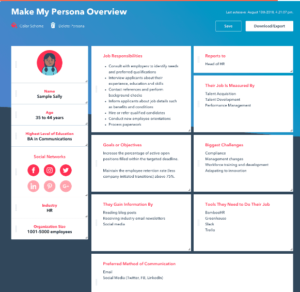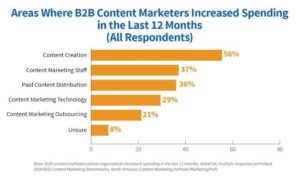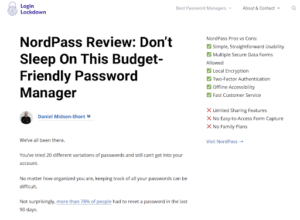Consumers today are more deliberate about their purchases. An estimated 59% of shoppers say they use Google to research purchases they plan to make in-store or online. Others turn to other digital channels like Facebook and Twitter.
How can you reach more consumers who are looking for products or services your business offers? The answer is with content marketing — a marketing strategy that involves creating and distributing content to attract your audience.
Content marketing can raise brand awareness and establish your business as an industry leader. Each piece of content you publish is also an opportunity for prospects to find your business online.
A strong content marketing strategy can ultimately drive more traffic to your site and generate more sales for your business. Here we’ll look at how you can grow your organic traffic with better content marketing.
#1. Define Your Target Audience
Defining your audience is key to implementing a content marketing strategy. Who is your ideal customer, and what are their interests? What are their preferred methods of communication?
Use data about your existing customers to help with your research. Then compile all your research into a buyer persona — a representation of who your customers are based on your research.
Creating a buyer persona is important because it enables you to deliver content that focuses on your target audience’s needs. Here’s an example of a buyer persona from HubSpot:

The more you understand about your audience, the better. Think about what their pain points are and how your products or services can solve them.
#2: Establish Your Marketing Goals
Having clearly defined objectives can help you, and everyone in your organization to stay focused on the bigger picture. What are your content marketing goals? Simply saying you want more traffic or sales is too broad.
Instead, follow the SMART methodology (Specific, Measurable, Achievable, Realistic, and Timely) to create a roadmap for your business. Then use your answers to plan your strategy accordingly.
For example, if your goal is to raise brand awareness, your focus will be more on top of the funnel content assets like educational resources. Define which metrics are important for your business before you invest in content marketing.
#3. Research Your Competitors
More companies are beginning to see the value of content marketing. 56% of B2B content marketers reported spending more on content creation.

That means competitors in your industry are likely using content marketing to attract customers. But it also represents a learning opportunity for your business.
Compile a list of the top competitors in your industry. What kind of content are they creating? What channels are they publishing on? How are their readers responding?
The idea here is to get a sense of what your competitors are doing. You should never directly copy your competitors. Instead, look for ways you can distinguish your content and provide even more value.
#4: Create In-Depth Content
Google’s ranking algorithm has grown increasingly sophisticated over the years. It used to be easy to produce a short 500-word article and get it ranked on the first page with only a few backlinks. But those days are long gone.
Google has gotten much better at delivering relevant and authoritative content. If you want to increase organic search traffic, focus on creating in-depth content that covers a topic comprehensively.
The average word count of the top 10 results is 1,447 words, according to Backlinko. They also found that long-form content generates more backlinks than shorter posts.

By creating factual and lengthy content, you’ll be able to gradually improve your search engine rankings and establish your business as an authority.
Consider your target audience. What topics are they searching for, and what questions are they asking? These are great starting points to create engaging content.
#5. Create Topic Clusters
This expands on the previous point. You can take your content marketing efforts even further with topic clusters. These consist of groups of interrelated content that link to a pillar page — a piece of content that covers a topic in-depth.
Topic clusters are beneficial from both a user and a search engine point of view. Users can learn more about a topic by clicking through to internal links, and Google can see that those pieces are related to each other.
Here’s an example of what a topic cluster looks like:

For example, if your business sells fitness equipment, you could create a pillar page on home gyms and then focus your cluster content on long-tail keywords that are related.
Building out a topic cluster like this isn’t easy, but it’ll help you rank for more keywords.
#6. Incorporate SEO
Incorporate
Optimize each of the following on-page
- Page titles
- Headers
- Meta descriptions
- Image ALT tags
- URLs
Be sure to include your keywords throughout your content. But don’t go overboard here — spamming your content with keywords can result in a ranking penalty.
This NordPass review offers an excellent example of a well-optimized page:

The review contains the primary keyword in the title. It’s also written in a way that makes it easy for visitors to read the page and find what they’re looking for.
Always focus on providing value to your visitors, and use a grammar checker with each piece to ensure your content flows.
#7. Create a Content Calendar
Writing down your marketing tasks on a piece of paper may work for a time. But you’ll eventually find it challenging to keep track of everything as you ramp up your content marketing efforts.
A content calendar is an editorial calendar that can streamline your content creation efforts and help you stay more organized. It provides an overview of what content to create and where it will be published.
As you create your content calendar, be sure to factor in any special events or holidays throughout the year. For example, if you’re in the tech industry, plan for creating content around the lucrative Black Friday shopping period.
Use Wordable with a content calendar to save time with formatting and publishing. This tool enables your writing team to quickly import content from Google Docs to WordPress, giving you time to focus on your strategy instead of tedious uploads.

#8. Multiply Your Content Marketing
Creating a blog is an effective way to increase your organic traffic. It allows you to share your expertise and reach your audience online. Each blog post you create is a marketing asset that can generate more leads for your business.
But keeping a blog post in one format is a wasted opportunity. For example, you can easily turn a single blog post into:
- Social media posts
- Guest posts
- White papers
- Infographics
- Webinars
- eBooks
- Videos
Online users today use different channels to consume media.
Turning content into multiple formats allows you to drive even more traffic to your site. It’s also a proven way to build backlinks and improve your rankings. Backlinks are an important ranking signal that tells Google that other websites are vouching for yours.
#9. Be Consistent With Your Marketing
Content marketing requires consistent effort to be successful. You can’t just publish one blog post and expect traffic to flood your site.
The key to growing your organic traffic is to publish content regularly. Use your content calendar to help you stay on track and consider building a team to scale your efforts. You can find talented writers on freelance platforms like Upwork.
As you scale your content marketing, it’s crucial to maintain a consistent voice across all media platforms. Create a brand style guide that you and your team can turn to before publishing content.
#10. Track Your Results
Implementing a content marketing strategy requires a great deal of effort. It’s easy to look at the content you’ve published and feel a sense of accomplishment. But did they actually bring in sales for your business?
The only way to know if your content is delivering ROI is to track your results. That way, you can determine what types of content resonate with your audience and whether to continue investing in a channel.
Don’t be afraid to adjust your content marketing strategy. If your data reveals you’re spending more on a channel than you’re getting back, it may be worth reconsidering that channel altogether.
Likewise, if a particular piece of content performs well, consider doubling down and producing more of it. Make it a point to check your Google Analytics on a regular basis and pivot as necessary.
Conclusion
More consumers are turning to digital channels to research purchases. An estimated 87% of shoppers conduct product searches online. These same individuals turn to a multitude of channels to inform their decisions.
Content marketing can help position your products or services in front of more prospects and generate more sales for your business. Implement the tips here to grow your organic traffic with better content marketing.
Bio:
Hann Wang, Content Marketer, Wordable
Hann is a content marketer at Wordable, a tool that helps you export Google Docs to WordPress instantly.
DepositPhotos – content marketing


